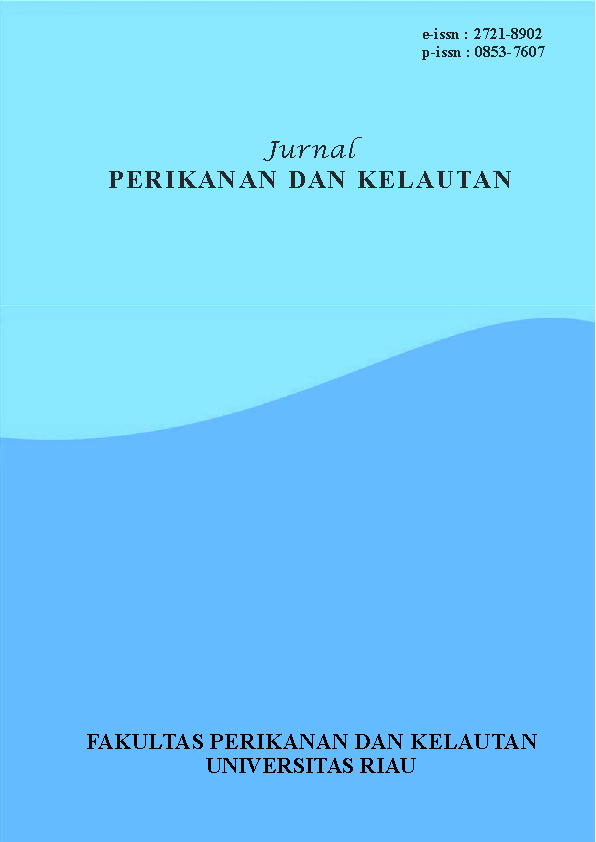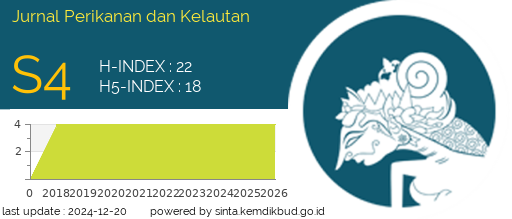Evaluation of Fish Cultivation Water Quality in Aquaponic Systems with Different Aeration Systems
DOI:
https://doi.org/10.31258/jpk.30.1.81-89Keywords:
Aquaponics, Aerations, Water quality, Dissolved oxygenAbstract
Aquaponics is a sustainable aquaculture technology that integrates a recirculation aquaculture system with plant cultivation in one system. The aquaponic system can be a solution that can be used as an intensive fish farming system and increase fish farming production. However, intensive cultivation will cause dissolved oxygen concentration to decrease rapidly. It will affect the water's quality, so an aeration system is needed to maintain the balance of dissolved oxygen in the water. The difference in the use of aeration systems in aquaponic systems will certainly provide different water quality results. So, this study aims to determine the type of aeration system most effective for cultivation activities in the aquaponic system. The method used in this study is a descriptive exploration of various literature and research results that have been published, both from books, national journals, and international journals. Based on a comparison of the results of previous studies, it can be concluded that aeration technology with microbubble sizes such as MNB and FBs can increase oxygen higher and more stable than conventional and venturi aeration technologies. The application of MNB and FBs aeration technology can produce water quality with dissolved oxygen concentration >7 mg/L, reduce ammonia concentration to <0.01 mg/L, nitrate concentration to <0.6 mg/L, and phosphate concentration <0.3 mg/L, as well as reducing total solids to 16% and volatile solids to 32%.
Downloads
References
Afdillah, R., Andriani, Y., Hasan, Z., Rosidah, R., & Iskandar, I. (2020). The Affection of Fine Bubbles (FBs) Application on Growth Siamese Catfish (Pangasianodon hypophthalmus) in Aquaponic System. Asian Journal of Fisheries and Aquatic Research, 7(4): 30-36.
Aldunate, M., DelaIglesia, R., Bertagnolli, A.D., & Ulloa, O. (2018). Oxygen Modulates Bacterial Community Composition in the Coastal Upwelling Waters Off Central Chile. Deep-Sea Research, 156: 68-79.
Andinet, T., Kim, I., & Lee, J.Y. (2016). Effect of Microbubble Generator Operating Parameters on Oxygen Transfer Efficiency in Water. Desalination and Water Treatment, 57(54): 1-9.
Andriani, Y., & Zahidah, Z. (2019). Akuaponik: Integrated Farming Yang Semakin Populer. Bitread Publishing.
Andriani, Y., Zahidah, Z., Anando, D.A., & Pratama, R.I. (2023). Productivity of Comet Goldfish (Carassius auratus) Cultured in Aquaponics System Using Fine Bubbles (FBs). Aceh Journal of Animal Science. 8(3): 121-128.
Andriani, Y., Zahidah., Dhahiyat, Y., Subhan, U., Zidni, I., Pratama, R.I., & Gumay, N.P. (2018). The Effectiveness of the Use of Filter on the Tilapia Growth Performance, Number of Nitrosomonas sp, and Water Quality in Aquaponics Systems. Jurnal Akuakultur Indonesia, 17(1): 1-8.
Arthanawa, N., Yana, A., Darmawan, I.K., Situmeang, Y.P., & Sudita, I.D.N. (2021). Utilization of Biofloc System Catfish Pond Waste Nutrients in the Cultivation of Kale, Spinach, Pakcoy, and Lettuce Using the Aquaponic System. SEAS (Sustainable Environment Agricultural Science), 5(1): 66-71.
Assaffah, T.S., & Primaditya, P. (2020). Media Tanam Akuaponik dalam Ruang. Jurnal Sains dan Seni ITS, 9(1): 19-25.
Bui, T. D., Van, J. L., Maier, S. W., & Austin, C.M. (2013). Assessment and Monitoring of Nutrient Loading in the Sediments of Tidal Creeks Receiving Shrimp Farm Effluent in Quang Ninh, Vietnam. Environmental Monitoring and Assessment, 185: 8715-8731.
Chen, Z., Cuervo, D.P., Müller, J.A., Wiessner, A., Köser, H., Vymazal, J., Kästner, M., & Kuschk, P. (2016). Hydroponic Root Mats for Wastewater Treatment: A Review. Enviromental. Science and Pollution Research, 23(16): 15911-15928.
Dauhan, R.E.S., Efendi, E., & Suparmono, S. (2014). Efektifitas Sistem Akuaponik dalam Mereduksi Konsentrasi Amonia pada Sistem Budidaya Ikan. E-Journal Rekayasa dan Teknologi Budidaya Perairan, 3(1): 297-302.
Diver, S. (2006). Aquaponics Integration of Hydroponics with Aquaculture. National Sustainable Agriculture Information Service. p28.
Djaelani, M.A., Kasianti, K., & Sunarno, S. (2022). Use of Filter and Addition of Aeration on Growth of Red Tilapia (Oreochromis niloticus). Jurnal Veteriner, 23(3): 371-379.
Estim, A., Shaleh, S.R.M., Shapawi, R., Saufie, S., & Mustafa, S. (2020). Maximizing Efficiency and Sustainability of Aquatic Food Production from Aquaponics Systems: A Critical Review of Challenges and Solution Options. Aquaculture Studies, 20(1): 65-72.
Farida, N.F., Abdullah, S.H., & Priyati, A. (2017). Analisis Kualitas Air pada Sistem Pengairan Akuaponik. Jurnal Ilmiah Rekayasa Pertanian dan Biosistem, 5(2): 385-394.
Hamdani, H., Suryadi, I.B., Zahidah, Z., Andriani, Y., Dewanti, L.P., & Sugandhy, R. (2022). Water Quality Management in Ebb and Flow Aquaponic System. Journal of Berdaya, 2(1): 1-7.
Hasan, Z., Andriani, Y., Dhahiyat, Y., Sahidin, A., & Rubiansyah, M.R. (2018). Pertumbuhan Tiga Jenis Ikan dan Kangkung Darat (Ipomoea reptans Poir) yang Dipelihara dengan Sistem Akuaponik. Jurnal Ikhtiologi Indonesia, 17(2): 175-184.
Lekang, O. I. (2013). Aquaculture Engineering 2nd Edition. John Wiley and Sons Ltd.
Marcelino, K.R., Wongkiew, S., Shitanaka, T., Surendra, K.C., Song, B., & Khanal, S.K. (2023). Micronanobubble Aeration Enhances Plant Yield and Nitrification in Aquaponic Systems. ACS ES&T Engineering, 3(11).
Maucieri, C., Nicoletto, C., Junge, R., Schmautz, Z., Sambo, P., & Borin, M. (2018). Hydroponic Systems and Water Management in Aquaponics: A Review. Italian Journal of Agronomy, 13(1): 1-11.
Mirzaei, F.S., Ghorbani, R., Hosseini, S.A., Haghighi, F.P., & Saravi, H.N. (2019). Associations between Shrimp Farming and Nitrogen Dynamic: A Model in the Caspian Sea. Aquaculture, 510: 323-328.
Mohan, M., Bhanu, P.C.H., Prasad, G.S., Srinu, R., Konduri, A., Goud, P.M.K., & Kumar, M.K. (2022). Application and Importance of Aeration System in Aquaculture Pond: A Review. Asian Journal of Microbiology, Biotechnology, and Environmental Science, 24(2): 371-377.
Nair, C.S., Manoharan, R., Nishanth, D., Subramanian, R., Neumann, E., & Jaleel, A. (2024). Recent Advancements in Aquaponics with Special Emphasis on its Sustainability. Journal of the World Aquaculture Society, 56(1): 1-39.
Naomi, M., Hasan, Z., Sumadi., Hamdani, H., Andriani, Y., & Subhan, U. (2020). Growth of Striped Catfish Fingerlings (Pangasianodon hypophthalmus) in Aquaponic System with Fine Bubbles (FBs) Application. Asian Journal of Fisheries and Aquatic Research, 7(2): 1-9.
Nugroho, R.A., Pambudi, L.T., Chilmawati D., & Haditomo, A.H.C. (2012). Aplikasi Teknologi Aquaponic pada Budidaya Ikan Air Tawar untuk Optimalisasi Kapasitas Produksi. Saintek Perikanan: Indonesian Journal of Fisheries Science and Technology, 8(1): 46-51.
Petersen, E.L. & Walker, M.B. (2002). Effect of Speed on Taiwanese Paddlewheel Aeration. Aquacultural Engineering. 26: 129-147.
Puspa, R.C., & Rawal, J.S. (2024). Integrating Aquaculture and Hydroponics: A Review of Aquaponics Systems and Their Sustainability. Engineering Heritage Journal (GWK), 5(2): 53-61.
Putra, D.A., Hasan, Z., Handaka, A.A., Hamdani, H., & Subhan, U. (2020). The Potential Effect of Using Fine Bubbles on the Growth Rate of Striped Catfish (Pangasianodon hypopthalmus) Fingerlings with Different Stocking Densities in Aquaponic Systems. Asian Journal of Fisheries and Aquatic Research, 7(2): 10-19.
Rully, R. (2011). Penentuan Waktu Retensi Sistem Akuaponik untuk Mereduksi Limbah Budidaya Ikan Nila Merah. Fakultas Perikanan dan Ilmu Kelautan. Institut Pertanian Bogor. Bogor.
Sarkar, B., Mahanty, A., Gupta, S.K., Choudhury, A.R., Daware, A., & Bhattacharjee, S. (2022). Nanotechnology: A Next-Generation Tool for Sustainable Aquaculture. Aquaculture, 546: 737330.
Sastro, Y. (2015). Akuaponik : Budidaya Tanaman Terintegrasi dengan Ikan, Permasalahan Keharaan dan Strategi Mengatasinya. Buletin Pertanian Perkotaan, 5(1): 33-42.
Shafrudin, D., Yuniarti, Y., & Setiawati, M. (2006). Pengaruh Kepadatan Benih Ikan Lele Dumbo (Clarias sp.) terhadap Produksi pada Sistem Budidaya dengan Pengendalian Nitrogen Melalui Penambahan Tepung Terigu. Jurnal Akuakultur Indonesia, 5(2): 137-147.
Shobihah, H.N., Yustiati, A., & Andriani, Y. (2022). Produktivitas Budidaya Ikan dalam Berbagai Konstruksi Sistem Akuaponik (Review). Jurnal Akuatika Indonesia, 7(1): 34-41.
Stathopoulou, P., Berillis, P., Levizou, E., Kormas, A.K., Aggelaki, A., Kapsis, P., Vlahos, N., & Mente, E. (2018). Aquaponics: A Mutually Beneficial Relationship of Fish, Plants, and Bacteria. Hydromedit,191-195.
Sultana, T., Haque, M.M., Salam, M.A., & Alam, M.M. (2017). Effect of Aeration on Growth and Production of Fish in Intensive Aquaculture System in Earthen Ponds. Journal of Bangladesh Agricultural University, 15(1): 113-122.
Tanveer, M., Roy, S.M., Vikneswaran, M., Renganathan, P., & Balasubramanian, S. (2018). Surface Aeration Systems for Application in Aquaculture: A Review. International Journal of Fisheries and Aquatic Studies, 6(5): 342-347.
Tezlaff, B.L. & Heidinger, R.C. (1992). Basic Principles of Biofiltration and System Design. SIUC Fisheries Research Laboratory.
Tsuge, H. (2015). Micro and Nanobubbles. Taylor and Francis Group, LLC.
Ullman, C., Rhodes, M.A., & Davis, D.A. (2019). Feed Management and the Use of Automatic Feeders in the Pond Production of Pacific White Shrimp. Litopenaeus vannamei. Aquaculture, 498: 44-49.
Utami, T.S.B., Hasan, Z., Syamsuddin, M.L., & Hamdani, H. (2019). Fitoremediasi Limbah Budidaya Ikan Koi (Cyprinus carpio) dengan Beberapa Tanaman Sayur dalam Sistem Resirkulasi Akuaponik. Jurnal Perikanan dan Kelautan, 10(2): 81-88.
Widyastuti, Y.R. (2008). Peningkatan Produksi Air Tawar melalui Budidaya Ikan Sistem Akuaponik. Prosiding Seminar Nasional Limnologi IV LIPI. 62-73.
Wongkiew, S., Park, M.R., Chandran, K., & Khanal, S.K. (2018). Aquaponic Systems for Sustainable Resource Recovery: Linking Nitrogen Transformations to Microbial Communities. Environmental Science and Technology, 52(21): 12728-12739.
Yaparane, S., Lopez, J.M., Bouchard, D., Segura, S.G., & Apul, O.G. (2024). Nanobubble Applications in Aquaculture Industry for Improving Harvest Yield, Wastewater Treatment, and Disease Control. Science of the Total Environment, 931: 172687.
Zahidah, Z., Andriani, Y., Anando, D.A., Hasani, S., & Pratama, R.I. (2022). Water Quality and Water Spinach Productivity in Aquaponic Systems Using Fine Bubbles (FBs). Jurnal Agro, 9(2): 252-264.
Zahidah, Z., Dhahiyat, Y., Andriani, Y., Sahidin, A., & Farizi, I. (2018). Impact of Red Water System (RWS) Application on Water Quality of Catfish Culture Using Aquaponics. IOP Conference Series: Earth and Environmental Science, 139(1): 1-8.








